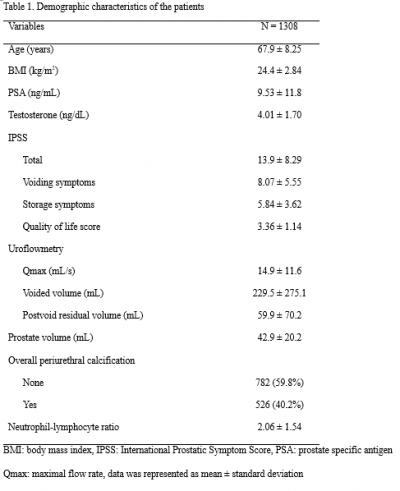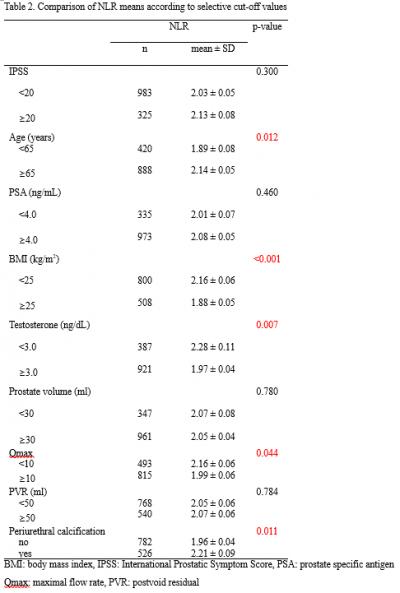|
|
|
하부요로증상이 적은 남성에게서 호중구-림프구 비율의 역할 |
| 전남대학교 의과대학 비뇨의학과교실 |
| 구진석, 조현진, 송재익, 이호연, 김재현, 임도경, 김태희, 은성종, 오주용, 유성현, 김명수, 정호석, 황의창, 오경진, 김선옥, 정승일, 강택원, 권동득, 박광성 |
Purpose:
To evaluate the association between lower urinary tract symptoms (LUTS) and Neutrophil-Lymphocyte Ratio (NLR), an index of inflammation
METHOD:
This study was conducted on a total of 1308 men who visited our outpatient clinic due to lower urinary tract symptoms from January 2015 to December 2019. We calculated the NLR from the peripheral blood sample for all patients. Patients' age, body mass index (BMI), total prostate-specific antigen (PSA), International Prostate Symptom score (IPSS), testosterone level, prostate volume, uroflowmetric parameters and periurethral calcification were recorded.
RESULTS:
The mean age and NLR were 67.9 ± 8.25 years and 2.06 ± 1.54, respectively. NLR significantly increased in the group of patients over age 65 years (p=0.012), under testosterone 3.0 ng/dL (p=0.007), under BMI 25kg/m2 (p<0.001), under Qmax 10ml/s (p=0.44), and who have periurethral calcification (p=0.011). IPSS, total PSA, prostate volume, and PVR showed no association with NLR in this study.
CONCLUSION:
This study found that NLR which is associated with inflammation status has correlation with some parameters of LUTS/BPH and low testosterone. Based on this, high NLR may be a possible marker for severity of symptoms in BPH patients. In addition, we suggest that anti-inflammatory therapy could have a role for medical treatment of LUTS/BPH. |
  |
|
keywords : Lower urinary tract symptoms, Neutrophil-Lymphocyte ratio, Benign prostatic hyperplasia |
|

